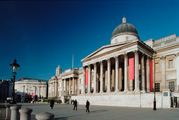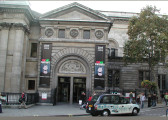American Art Exhibitions: ‘Coming of Age: American Art: 1850s-1950s’ and ‘The American Scene: Prints from Hopper to Pollock’
Originally published in March 2008 in American in Britain Magazine
‘Coming of Age: American Art, 1850s to 1950s’ reveals the complex and fascinating evolution of American artistic styles & culture at the Dulwich Picture Gallery
‘The American Scene: Prints from Hopper to Pollock’ Features around 150 outstanding prints by 74 leading modern American artists at the British Museum.
‘Coming of Age: American Art, 1850s to 1950s’, at the Dulwich Picture Gallery, tells a fascinating story about American artists and their search for a uniquely American voice. On loan from the Addison Gallery of American Art at the Phillips Academy in Andover, Massachusetts, the exhibition begins with landscape paintings of the Hudson River School and takes us through to the early 20th century where Ashcan School painters captured the daily realities of city life. The show concludes in the post-war period with the emergence of abstract expressionism and innovative sculpture – when American art played a leading role on the international stage. Throughout we witness an artistic, social and cultural transformation in subject matter, style and technique. The complexities and contradictions in maturing American society surface on canvas, in prints, etchings and in the use of new materials.
In searching for an American identity, the ‘Coming of Age’ exhibition raises key questions: What is American about American art? How can American art find an artistic vision distinct from its European counterparts and establish itself on grounds comparable to the proven traditions in Europe?(*1) An early response came from Asher Durand in the 1850s. Durand warned his art students “not to go abroad for the exercise of your pencil”. He argued that the proper subject matter for American painting was the natural paradise of America. This vision was shared by the Hudson River School of painters: Thomas Cole, Frederick Church and Albert Bierstadt. Durand’s oil, a ‘Study of a Wood Interior’, ca. 1855, seen here, perfectly illustrates a commitment to portray ‘truth to nature’. It is a dense depiction of nature with rotting logs, and lichen-covered rocks on the forest floor. This minute portraiture is almost philosophical and spiritual. There is a romantic, even transcendental sense of the natural wilderness captured in the work. Although highly regarded at the time, increasingly the parochial image embodied in this and other panoramic landscapes was felt to be too narrow and provincial. Critics and younger artists argued that America’s artistic heritage was essentially influenced by European sources. Many felt European standards of excellence were important criteria for assessing the aesthetic value of American art. This tension between Old and New World traditions remains to this day.
In the Post-Civil War period the artistic climate changed dramatically in the United States. Major museums and art schools in Boston and New York were established. The public were exposed to American paintings alongside British, French and German art at the 1876 Centennial Exposition in Philadelphia. Magazines about art such as The Atlantic Monthly (1857), The Century (1881), and the American Art Review (1880) fostered a more sophisticated understanding of the art world. Undoubtedly, European artistic trends were major influences. Artists such as Whistler, Homer, Sargent, Cassatt and Eakins went abroad where they studied in established French and German academies. Some even became expatriates and spent their mature lives abroad. James McNeil Whistler left Massachusetts for Paris, never returned and died in London. His painting ‘Brown and Silver: Old Battersea Bridge’, 1859-63, is a marked departure from the precise detailed paintings of the Hudson River School. With its asymmetrical composition in harmonious greys and browns, the influence of Japanese prints is evident. When comparing Whistler’s Battersea Bridge with Winslow Homer’s Eight Bells, 1886, we note “a vivid contrast between the energized and aggressive American realism of Homer and the elegant even ethereal European sensibilities of Whistler.”(*2)
Once American artists had learned the lessons of the Old Masters and French Impressionists, they travelled along more adventurous avenues. The effects of light and colour, village life and the Barbizon school helped them to shape their own version of Impressionism. A stunning example is Singer Sargent’s high-coloured Val d’Aosta: A Man Fishing, 1906, painted in the Italian Alps. This painting is an exuberant web of diagonals, cropped figures of fishermen painted in dashed strokes.
Back home American artists recorded urban, regional and patriotic scenes. In 1912 we note some remarkable genre paintings which captured leisured moments. Two good examples seen here are John Sloan’s Sunday, Women Drying their Hair and George Bellow’s The Circus. By the 1920s Cubist principles were found in the work of American artists. Critics debated whether Hopper’s Manhattan Bridge Loop, 1928, incorporated cubist theory. However, some felt his sense of colour and lateral movement defined the structure – a kind of realist version of the Cubist grid. (*3)
After the Second World War American art became firmly established internationally. Abstract impressionism and modern sculpture had arrived. While Charles Sheeler captured the monumental beauty of mills (see his Ballardvale, 1946), Jackson Pollock broke new ground with Phosphorescence in 1947. Phosphorescence presented the art world with an allover form of abstraction, a new kind of physicality which combined oil, enamel and aluminium paint on canvas. Calder’s lightweight mobiles and Smith’s sculptures incorporated new industrial techniques and were met with critical acclaim. By the 1950s American art had ‘come of age’. Many of the best known artists from this period are featured in the Dulwich Gallery. The exhibition offers visitors a rare opportunity to see the evolution in American art through several generations.
There is another ‘must-see’ exhibit: ‘The American Scene: Prints from Hopper to Pollock’ which opens April 10th 2008 at the British Museum. Featuring 147 works by 74 artists, this is the best collection of American prints outside the United States. The show is a perfect companion piece to the ‘Coming of Age’ exhibition at the Dulwich Picture Gallery. The prints capture memorable images of conspicuously American subjects from the early 1900s through the 1960s. We witness the rise of modernism following the landmark Armory Show in New York City in 1913. Urban imagery is contrasted with rural life. Artists were able to survive and flourish during the Great Depression due to The Works Progress Administration (WPA), a Federal Art Project which provided relief for unemployed artists. These iconic images convey a period of rapid social and political change.
Various episodes in print-making provide a stunning pictorial history of all levels of society. There is John Sloan’s etching Turning Out the Light; New York City Life, 1905 which shows a woman kneeling on her bed to turn out the light of a gas lamp. Edward Hopper’s etching, Night on the El Train, 1918, pictured here, is a story about a solitary couple who appear to be lost in conversation late at night on the subway. There is an elegant simplicity in Hopper’s use of line and shades of grey into black. And Thomas Hart Benton’s lithograph Frankie & Johnnie, 1936 portrays a bar scene with Frankie in a white dress holding a bucket and running toward and shooting Johnnie. Chaos and revenge seem to give this image a sense of urgency and movement. Benton has captured the situation with extraordinary clarity.
These prints tell much more than a thousand words could. Louis Lozowick’s 1925 lithograph New York, New York, a stark cityscape, is composed in a Precisionist manner. Remarkable, too, is Robert Gwathmey’s composition Share Croppers, 1944. The simplicity of a black man and his wife working with hoes in a featureless landscape says it all.
The British Museum’s collection of American prints really is outstanding. You will see a pictorial social and political history of America from the Jazz Age, the Depression years, America’s entry into World War Two, and the effect which the rise of Fascism in Europe had on the United States.
So – get out your diary and make a date to visit American art at the Dulwich Picture Gallery and the British Museum. And if you are so inclined, let me know if you enjoyed the shows.
Notes :
*1(Faxon catalogue: 16) *2 Faxon:52 *3 Faxon :101
Dates of Exhibits:
‘Coming of Age: American Art 1850s to 1950s’
14 March to 8 June 2008 –Entry fee
Dulwich Picture Gallery
Gallery Road
Dulwich Village
London SE21 7AD
http://www.dulwichpicturegallery.org.uk
Telephone : 020 8693 5254
Catalogue:
Coming of Age : American Art, 1850s to 1950s
by Susan Faxon & William Agee
American Federation of Arts &Yale University Press 2006
********************************
The American Scene: Prints from Hopper to Pollock
10 April to 7 September 2008 –Free
The British Museum
Great Russell Street
London WC1B 3DG
www.britishmuseum.org
Catalogue:
American Prints from Hopper to Pollock
by Stephen Coppel & Anthony Griffiths
Contact: Abby Cronin at www.abbycronin.co.uk
email: artsjournalist@abbycronin.co.uk



